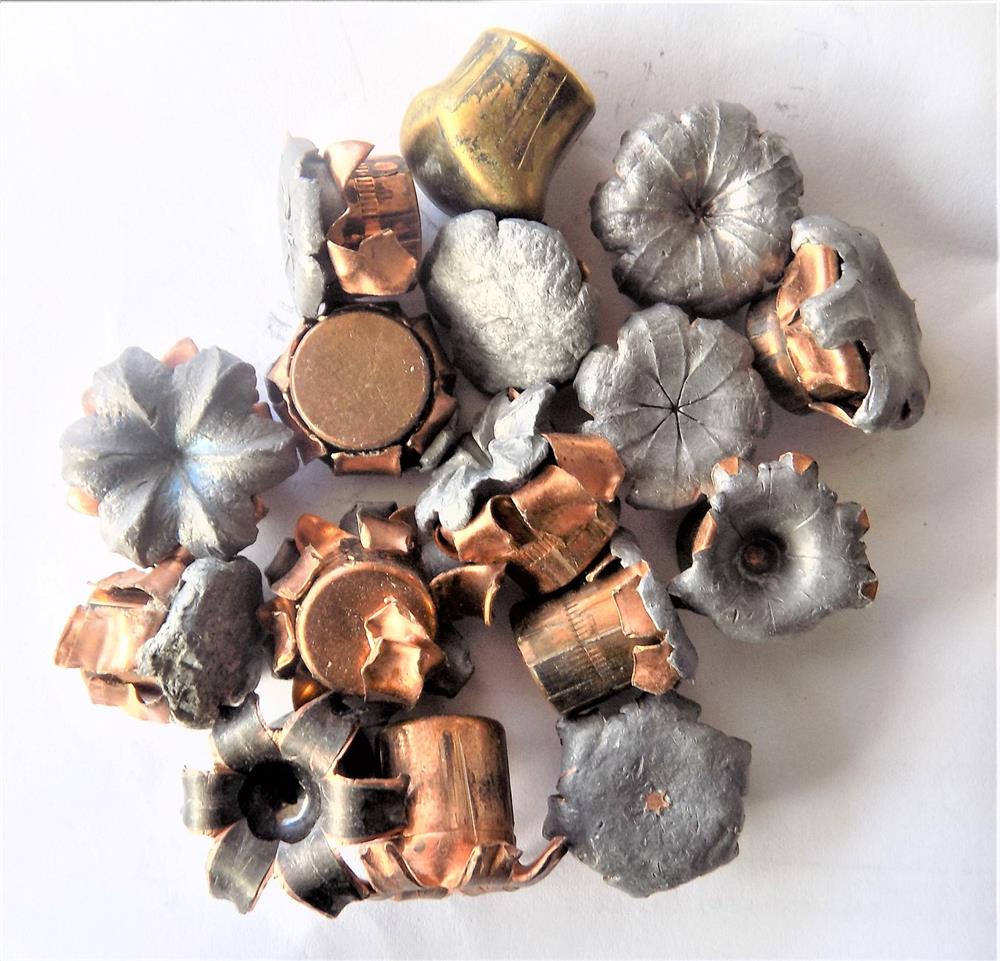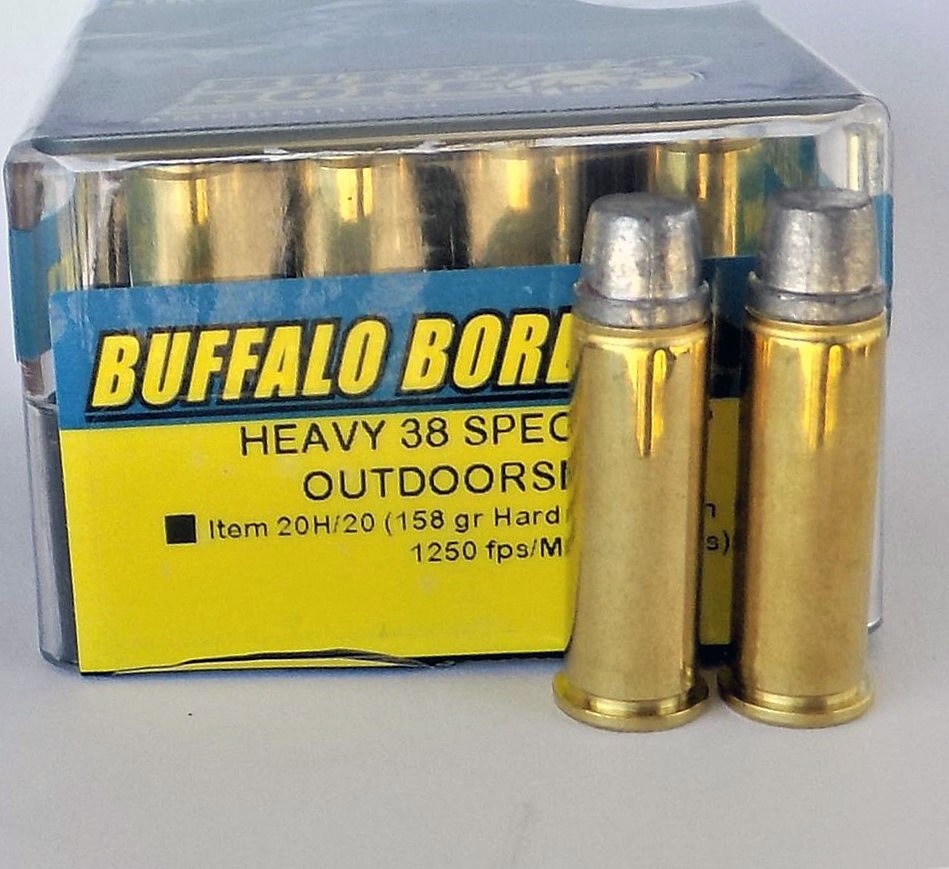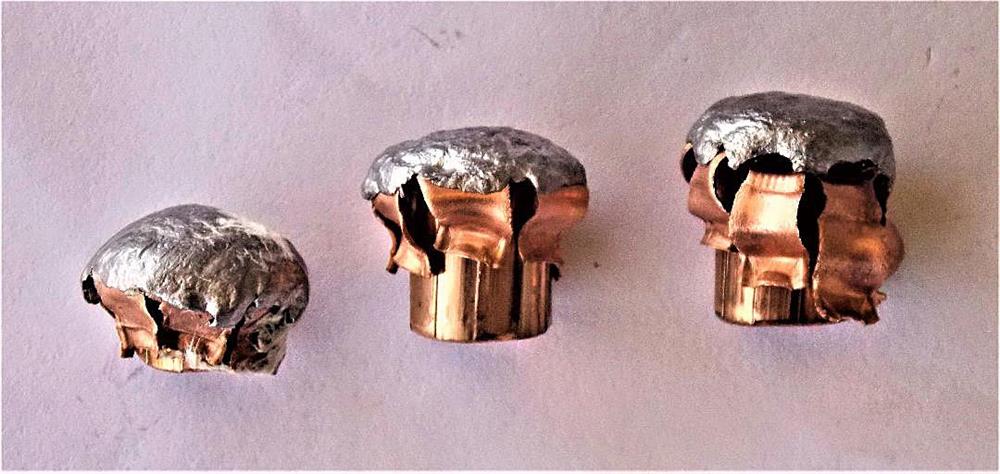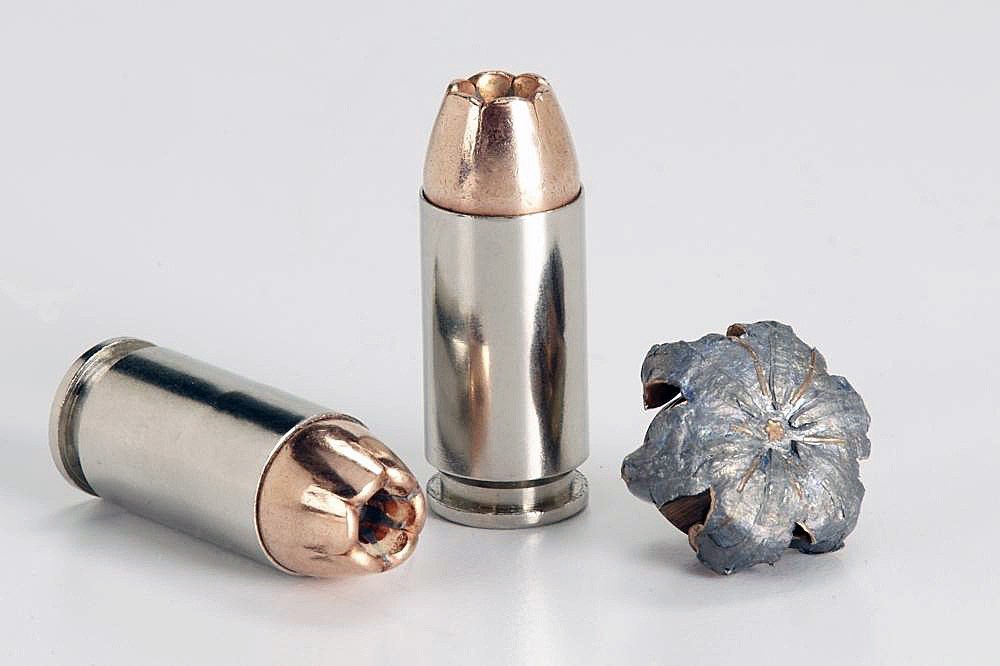There is only one reason to fire at another human being. That is to stop a threat. The threat must be so great that the only means of stopping violent action is to fire. It must not matter morally or legally if the individual dies as a result of being shot. This is serious business that demands care when choosing the handgun and its ammunition for personal defense.

It may be debated which is the more important. The handgun is simply a projectile launcher in some ways, but in other ways it is important to choose a proper handgun. Ammunition selection is also important. Although some downplay caliber selection—erroneously I believe—with good shot placement calibers such as 9mm and .38 Special may be effective.
The single most important criteria of wound potential is penetration. When a small caliber performs beyond expectation it is because it penetrated well. When a big bore fails, it is usually because of poor penetration. I am very careful concerning recommendations. The following observations are valid, I believe, and the loads examined are reliable and offer good performance.
The Problem of Wound Potential
When an expanded .45 enters the arterial region, all events are canceled. Given adequate penetration, a blunt nose that causes damage to tissue and blood loss, many calibers and ammunition combinations have the potential to perform in a similar manner. The desired result is a shutdown of the threat as quickly as possible.
Historically, larger calibers are more effective than small calibers. Many of these large bore handguns also use heavier bullets. I believe, in most cases, the heavy-for-the-caliber bullet is a good choice. While lighter bullets may be driven at a higher velocity, this isn’t always desirable.

Energy favors velocity, but momentum favors weight. Bullet expansion is also desirable but never at the cost of penetration. A felon may be heavily clothed, as in heavy winter clothing. Our protein fed ex-con criminal class may be heavily muscled and they may be large heavy individuals.
Bone is hard and not easily penetrated. A round-nosed bullet may bounce off bone. Even the best-designed hollow point bullets may close up on striking bone or plug with material and fail to expand.
The single most important function of wound potential is shot placement. Next comes penetration. While heavy-for-the-caliber bullets may be slower in comparison, most achieve well over 1,000 fps. This is sufficient to instigate expansion with modern designs such as the Hornady XTP and Speer Gold Dot.
A balance of expansion and penetration is needed, with 12 inches a realistic minimum for personal defense. You must look at the total wound value. A rapidly-expanding bullet may produce a shallow, but wide, wound while a deep penetrating bullet that expands to an extent will produce a larger total wound along its path. This means greater wound damage and greater blood loss.

Caliber Choices
Calibers below .38 Special and 9mm Luger do not have sufficient power to achieve both penetration and expansion. If you bet your life on a small bore, then it isn’t an even bet at all. The 9mm and .38 Special are realistic minimum calibers for personal defense.
Test Results and Choices
.38 Special
The original .38 Special loading was a 158-grain RNL bullet at 750 fps. This is no powerhouse. The RNL bullet simply pushed flesh aside rather than cutting. There are plenty of records concerning this load. Performance leaves much to be desired earning the title widow maker in police service.
Most attempts at improving the .38 Special revolved around changing the bullet shape to produce a more complex wound. By dropping bullet weight to 110 to 125 grains, the .38 Special could obtain a velocity over 1,000 fps. This was thought necessary for bullet expansion. Sometimes these bullets underpenetrate. The use of a soft lead hollow point allows expansion at lower velocity with a full weight 158-grain lead hollow point. Bullet technology also allows good bullet expansion at less than 1,000 fps with jacketed bullets of good design.
.38 Special Load Choices
If you are using a K frame revolver or a .357 Magnum revolver for personal defense, among the best choices available is the Buffalo Bore 158-grain LSWCHP. This load offers good expansion and excellent penetration. Recoil is stout, as the load breaks 980 fps in a two-inch barrel, but the result is getting the tired old .38 Special off of its knees. In four-inch barrel revolvers, velocity may be as much as 1,050 fps. The soft lead bullet isn’t jacketed allowing good upset at modest velocity.

Gold Dot Technology
The Speer Gold Dot isn’t a lightweight personal defense load but at 135 grains, it is lighter than some. This load breaks over 900 fps in a snub nose revolver. This is impressive. Recoil is manageable, and the Gold Dot expands well in testing. This is a consistently expanding load that is among the best loads available for snub nose revolvers.
9mm Luger
I have tested more 9mm loads than other calibers because the 9mm is everyone’s cartridge and makes a giant footprint in the market. This is a powerful number with good performance—in the right loading. The 9mm has posted dismal results with non-expanding loads. Sometimes, lightweight bullets under penetrate. We train not for the average event but for the worst-case scenario. The 147-grain load provides a balance of expansion and penetration that favors penetration.
The 135-grain weight is a fairly new weight choice in 9mm with much promise. The FBI recently adopted Hornady’s 135-grain Critical Duty. This is a loading with an ideal balance of penetration and expansion that meets or exceeds all FBI Standards.
Speer Gold Dot 147-grain
Speer’s 147-grain Gold Dot is an accurate loading that has functioned well in all 9mm handguns I have tested. Expansion is greater than most 147-grain loads. The Gold Dot offers excellent barrier penetration. A good point of the Gold Dot is first class accuracy potential. This loading breaks 980 fps from the Glock 45 and 940 fps from the Mossberg MC1.
Winchester 147-grain PDX
At 940 fps, this load is controllable and accurate. Penetration is good and while expansion is modest the load demonstrates good load integrity with little unburned powder. Penetration is long and expansion is .46.

Federal 147-grain HST
Also available in a +P version with a 50 fps super charge, the HST offers greater expansion than other 147-grain loads. Penetration is good at over 1,000 fps. This load is a fast loading. For those who decry modest expansion in a 147-grain 9mm, the HST is an answer.
Federal 135-grain Hydra-Shok Deep Penetrating
This load features a balance of expansion and penetration that favors penetration. The bullet expands well and offers good penetration. Expansion is, on average, greater than the 147-grain loads while giving up little in terms of penetration.
Hornady 135-grain Critical Duty
The choice of the FBI, the 1,050 fps Hornady load is controllable, even docile, to fire. Performance is excellent across the board in all respects. At 1,060 to 1,080 fps in the test handguns, this load is controllable. Barrier penetration is predictably excellent all around. There is no more heavily tested 9mm load in history.
Fiocchi 147-grain JHP
I have often used this loading as a practice load for any 9mm that deploys the 147-grain JHP. The Fiocchi loading is high quality, accurate, and affordable. Fifty-round boxes are little more expensive than most 20 round 9mm JHP boxes. The Fiocchi load breaks about 940 fps average in a wide range of handguns. Penetration is in line with most 147-grain loads and expansion .46 on average. There are other loads including the Remington 147-grain Golden Saber and Double Tap 147-grain JHP that offer promise.
Double Tap 165-grain 9mm — King of the Heavies
Double Tap offers a heavy 9mm with a 115-grain JHP loaded over a 50-grain round nose lead bullet. This load depends on the principle of multiple hits causing more damage and shutting the body down. At modest velocity—965 fps—the 115-grain JHP expands less than fast stepping loads and the 50-grain ball trails behind. This is a load worth considering.
.357 Magnum
Much of the research in .357 Magnum personal defense loads revolved around 110- to 125-grain loads. There are issues with bullet pull and firearms wear, but these loads—especially the 125-grain loads—offer proven wound potential. Just the same, I prefer heavier bullets for most chores.

Muzzle blast and even recoil are less with the heavier bullets, in my opinion, and they offer an excellent balance of expansion and penetration. Take a hard look at these loads. While velocity was clocked from a four-inch barrel revolver, those using a six-inch barrel revolver will find ever-greater performance. As an example, the six-inch barrel Model 19 clocked over 1,300 fps with the 158-grain Winchester Ammunition loading.
Hornady Critical Duty
I was surprised Hornady offered a duty load in .357 Magnum at this stage of the game with practically all service weapons these days being self-loaders. This is a modified version of the 9mm service bullet with a tougher construction for magnum velocity. The Critical Duty relies on a polymer plug to instigate expansion. This load is as fast as most 125-grain loads at 1,405 fps. Yet, it offers a full 18 inches of penetration and good expansion. Accuracy is excellent.
Winchester Silvertip
This is among my favorite loads in any caliber. The 145-grain Silvertip is what the magnum is about, in my opinion, with 1,290 fps and excellent momentum and penetration. Considering flash, blast, recoil, accuracy, and overall performance, I prefer this load to the 125-grain JHP. It is also among the most accurate .357 Magnum loads I have tested.
Federal 180-grain JHP
This is the heaviest bullet tested in .357 Magnum. Velocity is 1,060 fps in the four-inch barrel L frame revolver and a strong 1,171 fps in the six-inch barrel Model 19. Before you write the Federal 180-grain load off as over penetrative, take a look at the chart and its expansion. If you have seen what this load does to a deer, your opinion may change.

.40 Smith and Wesson
The .40 S&W arguably needs less help than most calibers. .40 loads were designed from the beginning for penetration against barriers. The .40 was also the first cartridge designed specifically for JHP bullets. 180-grain JHP loads offer a good balance of expansion and penetration with gelatin penetration running 18-20 inches and expansion .68 to .72 inch.
The Hornady 180-grain XTP is a standout. Accuracy is good, and the load is viable for defense against felons behind cover or even for animal defense. The Winchester 180-grain PDX is comparable.
10mm
The 10mm was originally introduced with a 200-grain bullet. Today, there are loads from 135 to 200 grains. I think the 200-grain bullet is the best choice for a full power 10mm.
The Speer 200-grain Gold Dot was introduced recently, and this loading demonstrates excellent penetration at over 20 inches and good expansion. The Gold Dot breaks 1,180 fps in the SIG 10mm. I prefer this bullet weight to the 155- and 180-grain loads. The Gold Dot load gets into desirable territory not only for personal and home defense and defense against feral animals.
.45 ACP
Some years ago, I read a professional report that calculated hit probability of major police weapons including .38 and .357 revolvers and the 9mm and .45 ACP handgun. This report also stressed the superiority of the 230-grain .45. Many of the loads available today were not available then, but just the same, I feel that the 230-grain JHP offer the best choice for the .45 ACP in all barrel lengths.

Among the best choices is the Federal 230-grain HST. This load offers a good balance of expansion and penetration. The 230-grain weight is the weight originally intended for the .45 ACP and it functions well in all handguns. Hornady offers a 230-grain +P version at over 900 fps. Recoil becomes a factor with the +P load but it is a viable option in steel frame handguns.
Remington Black Belt
This loading is an improvement over an already outstanding design. The Golden Saber is the basis for the present Black Belt. The design uses the jacket, a brass covering, for expansion, which is different than most projectiles.
The Black Belt aids in gripping the barrel for accuracy. This is an accurate load with a good balance of expansion and penetration.
Hornady 220-grain Critical Duty
In this case Hornady dropped the traditional bullet weight a reasonable 10 grains to increase standard .45 ACP velocity from 850 to 1,000 fps. The result is a loading with plenty of power and penetration, good expansion, and modest recoil. This is arguably one of the best service loads available.
Take a hard look at heavy for the caliber bullets. Some are standard bullet weights others are heavier than standard, and all offer viable performance.
Average Penetration and Expansion In Water Media
Load |
Velocity |
Penetration |
Expansion |
|---|---|---|---|
.38 Special | |||
| Buffalo Bore 158-grain LSWCHP | 983 fps | 16 in. | .58 |
| Speer 135-grain Gold Dot | 905 fps | 13 in. | .62 |
9mm | |||
| Speer 147-grain Gold Dot | 970 fps | 20 in. | .68 |
| Federal 147-grain HST | 1,006 fps | 22 in. | .68 |
| Federal 135-grain DP | 1,035 fps | 22 in. | .79 |
| Fiocchi 147-grain JHP | 952 fps | 24 in. | .46 |
| Fiocchi 147-grain JHP | 952 fps | 24 in. | .46 |
| Winchester 147-grain JHP | 940 fps | 23 in. | .54 |
| Double Tap 147-grain JHP | 1,120 fps | 22 in. | .55 |
| Double Tap 165-grain Equalizer | 965 fps | 23 in. | .54 |
| Ball | —– | 16-18 inches average | —– |
.357 Magnum | |||
| Hornady 135-grain Critical Duty | 1,400 fps | 18 in. | .62 |
| Winchester 158-grain JHP | 1,180 fps | 18 in. | .68 |
| Winchester 145-grain Silvertip | 1,290 fps | 16 in. | .70 |
| Federal 180-grain JHP | 1,099 fps | 19 in. | .72 |
.40 S&W | |||
| Hornady 180-grain XTP | 980 fps | 20 in. | .70 |
| Remington 180-grain Golden Saber | 968 fps | 15 in. | .65 |
| Winchester 180-grain PDX | 980 fps | 16 in. | .68 |
10mm | |||
| Speer 200-grain Gold Dot | 1,180 fps | 24 in. | .66 |
| CCI Blazer 180-grain | 1,050 fps | 20 in. | .60 |
.45 ACP | |||
| Hornady 230-grain XTP +P | 909 fps | 16 in. | .70 |
| Remington 230-grain Black Belt | 845 fps | 20 in. | .68 |
| Hornady 220-grain Critical Duty | 970 fps | 14 in. | .71 |
Note: Gelatin results will usually be about 10 percent less in penetration compared to water testing.













